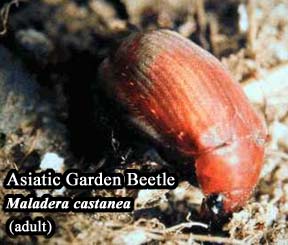Sunflower (Helianthus)
Plant Health Problems
Diseases caused by Fungi:
Rust, Puccinia helianthi.
Symptoms of rust infection are first visible as chlorotic lesions on the upper leaf surface. Diagnostic symptoms then develop on the underside of the leaf and appear as pustules which break open to reveal the orange-rusty powdery spores for which this disease get its name. Rusts can result in some defoliation when infection is heavy, especially when plants are crowded.
This disease can be minimized by cleaning up plant refuse in the fall and by adequate spacing of the plants to promote good air circulation. Although not usually necessary, applications of fungicides can be made when new growth emerges in the spring. Among the compounds registered for use in Connecticut are mancozeb and maneb. Consult the label for dosage rates and safety precautions.
Powdery mildew, Erysiphe cichoracearum.
White powdery spots or patches develop on leaves and occasionally on stems. Symptoms often first appear on the upper surfaces of the leaves and are usually most pronounced during hot, humid weather. Heavily infected leaves turn brown and shrivel.
Disease can be minimized by avoiding overcrowded spacing of plants and by carefully picking off affected leaves as soon as symptoms are evident. Symptomatic leaves can be placed into a plastic bag in order to avoid spreading the spores of the fungus to other plants. Use of fungicides is usually not necessary. However, applications can be made as soon as symptoms are visible. Among the compounds registered for use in Connecticut are horticultural oil, sulfur, potassium bicarbonate, and thiophanate-methyl. Consult the label for dosage rates and safety precautions.
Leaf spots, Septoria, Alternaria.
Circular to irregular tan to brown spots develop on leaves. These can vary in size, color, and number, depending upon the pathogen.
Efforts to maximize plant vigor by fertilizing and watering are helpful. However, watering should be done early in the day to give the foliage a chance to dry before nighttime. It is also helpful to pick and remove symptomatic leaves as soon as they develop. Although not usually necessary, applications of fungicides can be made when new growth emerges in the spring. Among the compounds registered for use in Connecticut are mancozeb and thiophanate-methyl. Consult the label for dosage rates and safety precautions.
Downy mildew, Plasmopara.
Early symptoms of infection often go unnoticed and appear as slightly chlorotic areas on the upper leaf surface. Diagnostic symptoms develop as the fungus grows and breaks through the lower leaf surface and appears as a purplish-gray fuzzy growth. When infection is heavy, leaves shrivel and die.
Efforts to maximize plant vigor by fertilizing and watering are helpful. However, watering should be done early in the day to give the foliage a chance to dry before nighttime. This disease can be minimized by cleaning up plant refuse in the fall and by adequate spacing of the plants to promote good air circulation. Although not usually necessary, applications of fungicides can be made when new growth emerges in the spring. Among the compounds registered for use in Connecticut is mancozeb. Consult the label for dosage rates and safety precautions.
Insect Problems: Asiatic garden beetle Maladera castanea.
Asiatic garden beetle Maladera castanea.
Adults are 3/8" long, dull cinnamon brown, with a faint iridescent sheen. They are active night fliers, attracted to lights, and are injurious as adults when they feed on many kinds of plants. During the day, the beetles hide in the soil around the plants and are seldom seen unless one knows where to find them. If needed, azadirachtin or carbaryl, which are among the compounds registered for control of this pest in Connecticut, can be applied to foliage when adults are present. Otherwise, treating with imidacloprid as a systemic may kill adults feeding on the foliage. Consult the label for dosage rates and safety precautions. Grubs of this and other beetle species can eat sunflower roots as well as those of turf. Treating nearby lawns for grubs will reduce the population. See Lawns, oriental beetle.
Sunflower maggot, Strauzia longipennis.
The larvae of this fly frequently occur in considerable numbers inside the stalks of sunflower, weakening them so that they break over. The maggots feed next to the woody stem and leave a cylindrical core of pitch detached. The fly has banded wings and belongs to the same group and feeds in about the same manner as the cherry fruit fly. The adults may be controlled by spraying the leaves with malathion several times during the growing season.

